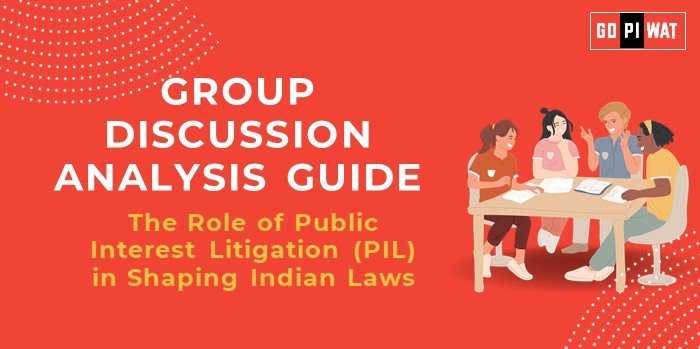📋 Group Discussion (GD) Analysis Guide: The Role of Public Interest Litigation (PIL) in Shaping Indian Laws
🌐 Introduction to the Role of Public Interest Litigation in Indian Laws
Opening Context: Public Interest Litigation (PIL) has revolutionized access to justice in India, providing a legal avenue for citizens and organizations to address social, environmental, and governance issues. It empowers the judiciary to act proactively in safeguarding public rights.
Topic Background: Introduced in the 1980s by judicial activism, PIL aims to democratize legal access and address systemic challenges. Landmark cases like Vishaka v. State of Rajasthan (1997) and environmental interventions have showcased its profound influence on Indian jurisprudence.
📊 Quick Facts and Key Statistics
- Origins: First PIL admitted in 1980 in the case of Hussainara Khatoon v. Home Secretary, Bihar, addressing prisoners’ rights.
- Landmark Cases: Over 25% of Supreme Court judgments since 2000 involve PILs.
- Environmental Wins: 22+ major environmental laws shaped by PILs, including the Ganga pollution cleanup directives.
- Global Context: Similar tools exist globally, such as class-action suits in the USA.
- Accessibility: Reduced procedural barriers make PIL a critical tool for marginalized communities.
👥 Stakeholders and Their Roles
- Judiciary: Proactive in hearing cases and issuing landmark judgments.
- Government: Often a respondent in PILs, addressing systemic gaps identified by the judiciary.
- Civil Society: Plays a crucial role in identifying and filing PILs for public interest.
- Academicians and Think Tanks: Contribute data and research to support PIL cases.
🏆 Achievements and Challenges
✨ Achievements:
- Environmental Protection: Led to the creation of laws like the Environment Protection Act, 1986.
- Rights Expansion: Addressed women’s rights (Vishaka Guidelines) and prisoner reforms.
- Transparency: Judicial scrutiny via PILs has promoted government accountability.
⚠️ Challenges:
- Judicial Overreach: Critics argue PILs sometimes blur the separation of powers.
- Frivolous Petitions: About 30% of PILs are dismissed annually as non-serious.
- Delay in Justice: Resource strain on courts affects timely judgment delivery.
🌍 Global Comparisons:
- USA: Class-action lawsuits offer similar public remedies.
- South Africa: Constitutionally integrated public litigation mechanisms.
📚 Case Studies:
- Oleum Gas Leak Case (1986): Expanded the principle of absolute liability.
- MC Mehta v. Union of India: Resulted in significant environmental protections.
📌 Structured Arguments for Discussion
- Supporting Stance: “PILs empower citizens to challenge government inaction, evident in environmental successes like the Ganga cleanup efforts.”
- Opposing Stance: “The misuse of PILs strains judicial resources and delays cases affecting individuals.”
- Balanced Perspective: “While PILs address critical public issues, judicial reforms are necessary to reduce frivolous litigation.”
🛠️ Effective Discussion Approaches
- Opening Techniques:
- Historical Context: “The evolution of PILs from the 1980s highlights its role in making justice more accessible to the marginalized.”
- Case Example: “The Vishaka Guidelines showcase how PILs can shape laws to address societal gaps.”
- Counter-Argument Handling:
- “While judicial overreach is a concern, stricter scrutiny of admissible PILs can mitigate this without diluting its benefits.”
📈 Strategic Analysis of Strengths and Weaknesses
- Strengths: Accessible justice, enhanced accountability.
- Weaknesses: Resource strain, risk of overreach.
- Opportunities: Codify PIL rules, improve legal awareness.
- Threats: Frivolous petitions, potential misuse.
🌟 Connecting with B-School Applications
Real-World Applications: PIL themes link to public policy, governance, and CSR frameworks.
Sample Interview Questions:
- “Discuss the role of PILs in environmental governance.”
- “How can courts balance activism and procedural discipline in PIL cases?”
Insights for Students: PILs offer lessons in stakeholder collaboration, legal reform, and resource optimization.


